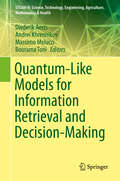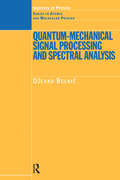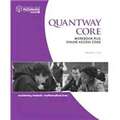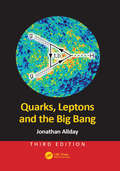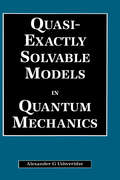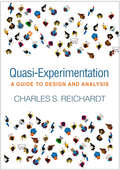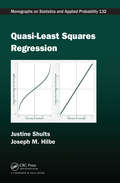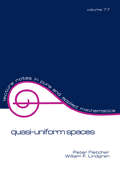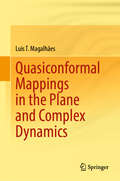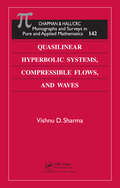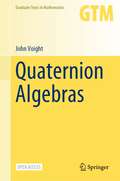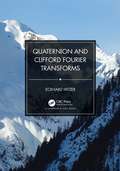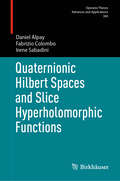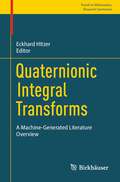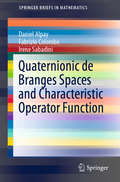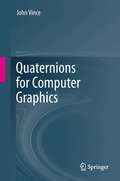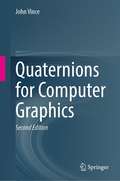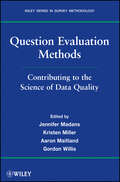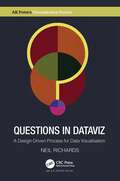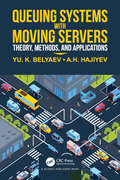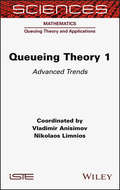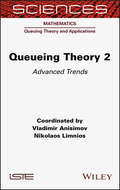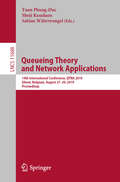- Table View
- List View
Quantum-Like Models for Information Retrieval and Decision-Making (STEAM-H: Science, Technology, Engineering, Agriculture, Mathematics & Health)
by Bourama Toni Andrei Khrennikov Diederik Aerts Massimo MelucciRecent years have been characterized by tremendous advances in quantum information and communication, both theoretically and experimentally. In addition, mathematical methods of quantum information and quantum probability have begun spreading to other areas of research, beyond physics. One exciting new possibility involves applying these methods to information science and computer science (without direct relation to the problems of creation of quantum computers). The aim of this Special Volume is to encourage scientists, especially the new generation (master and PhD students), working in computer science and related mathematical fields to explore novel possibilities based on the mathematical formalisms of quantum information and probability. The contributing authors, who hail from various countries, combine extensive quantum methods expertise with real-world experience in application of these methods to computer science. The problems considered chiefly concern quantum information-probability based modeling in the following areas: information foraging; interactive quantum information access; deep convolutional neural networks; decision making; quantum dynamics; open quantum systems; and theory of contextual probability. The book offers young scientists (students, PhD, postdocs) an essential introduction to applying the mathematical apparatus of quantum theory to computer science, information retrieval, and information processes.
Quantum-Mechanical Signal Processing and Spectral Analysis (Series in Atomic Molecular Physics)
by Dzevad BelkicQuantum-Mechanical Signal Processing and Spectral Analysis describes the novel application of quantum mechanical methods to signal processing across a range of interdisciplinary research fields. Conventionally, signal processing is viewed as an engineering discipline with its own specific scope, methods, concerns and priorities, not usually encompassing quantum mechanics. However, the dynamics of systems that generate time signals can be successfully described by the general principles and methods of quantum physics, especially within the Schroedinger framework. Most time signals that are measured experimentally are mathematically equivalent to quantum-mechanical auto-correlation functions built from the evolution operator and wavefunctions. This fact allows us to apply the rich conceptual strategies and mathematical apparatus of quantum mechanics to signal processing. Among the leading quantum-mechanical signal processing methods, this book emphasizes the role of Pade approximant and the Lanczos algorithm, highlighting the major benefits of their combination. These two methods are carefully incorporated within a unified framework of scattering and spectroscopy, developing an algorithmic power that can be exported to other disciplines. The novelty of the author's approach to key signal processing problems, the harmonic inversion and the moment problem, is in establishing the Pade approximant and Lanczos algorithm as entirely algerbraic spectral estimators. This is of paramount theoretical and practical importance, as now spectral analysis can be carried out from closed analytical expressions. This overrides the notorious mathematical ill-conditioning problems with round-off errors that plague inverse reconstructions in those fields that rely upon signal processing. Quantum-Mechanical Signal Processing and Spectral Analysis will be an invaluable resource for researchers involved in signal processing across a wide range of disciplines.
Quarks, Leptons and the Big Bang
by Jonathan AlldayCHOICE: Highly Recommended Quarks, Leptons and The Big Bang, Third Edition, is a clear, readable and self-contained introduction to particle physics and related areas of cosmology. It bridges the gap between non-technical popular accounts and textbooks for advanced students. The book concentrates on presenting the subject from the modern perspective of quarks, leptons and the forces between them. This book will appeal to students, teachers and general science readers interested in fundamental ideas of modern physics. This edition brings the book completely up to date by including advances in particle physics and cosmology, such as the discovery of the Higgs boson, the LIGO gravitational wave discovery and the WMAP and PLANCK results.
Quasi-Exactly Solvable Models in Quantum Mechanics
by A.G UshveridzeExactly solvable models, that is, models with explicitly and completely diagonalizable Hamiltonians are too few in number and insufficiently diverse to meet the requirements of modern quantum physics. Quasi-exactly solvable (QES) models (whose Hamiltonians admit an explicit diagonalization only for some limited segments of the spectrum) provide a practical way forward.Although QES models are a recent discovery, the results are already numerous. Collecting the results of QES models in a unified and accessible form, Quasi-Exactly Solvable Models in Quantum Mechanics provides an invaluable resource for physicists using quantum mechanics and applied mathematicians dealing with linear differential equations. By generalizing from one-dimensional QES models, the expert author constructs the general theory of QES problems in quantum mechanics. He describes the connections between QES models and completely integrable theories of magnetic chains, determines the spectra of QES Schrödinger equations using the Bethe-Iansatz solution of the Gaudin model, discusses hidden symmetry properties of QES Hamiltonians, and explains various Lie algebraic and analytic approaches to the problem of quasi-exact solubility in quantum mechanics.Because the applications of QES models are very wide, such as, for investigating non-perturbative phenomena or as a good approximation to exactly non-solvable problems, researchers in quantum mechanics-related fields cannot afford to be unaware of the possibilities of QES models.
Quasi-Experimentation: A Guide to Design and Analysis (Methodology in the Social Sciences)
by Charles S. ReichardtFeaturing engaging examples from diverse disciplines, this book explains how to use modern approaches to quasi-experimentation to derive credible estimates of treatment effects under the demanding constraints of field settings. Foremost expert Charles S. Reichardt provides an in-depth examination of the design and statistical analysis of pretest–posttest, nonequivalent groups, regression discontinuity, and interrupted time-series designs. He details their relative strengths and weaknesses and offers practical advice about their use. Comparing quasi-experiments to randomized experiments, Reichardt discusses when and why the former might be a better choice than the latter in the face of the contingencies that are likely to arise in practice. Modern methods for elaborating a research design to remove bias from estimates of treatment effects are described, as are tactics for dealing with missing data and noncompliance with treatment assignment. Throughout, mathematical equations are translated into words to enhance accessibility. Adding to its discussion of prototypical quasi-experiments, the book also provides a complete typology of quasi-experimental design options to help the reader craft the best research design to fit the circumstances of a given study.
Quasi-Least Squares Regression (Chapman & Hall/CRC Monographs on Statistics and Applied Probability)
by Justine Shults Joseph M. HilbeDrawing on the authors' substantial expertise in modeling longitudinal and clustered data, Quasi-Least Squares Regression provides a thorough treatment of quasi-least squares (QLS) regression-a computational approach for the estimation of correlation parameters within the framework of generalized estimating equations (GEEs). The authors present a d
Quasi-Uniform SPates (Lecture Notes In Pure And Applied Mathematics Ser. #77)
by FletcherSince quasi-uniform spaces were defined in 1948, a diverse and widely dispersed literatureconcerning them has emerged. In Quasi-Uniform Spaces, the authors present a comprehensivestudy of these structures, together with the theory of quasi-proximities. In additionto new results unavailable elsewhere, the volume unites fundamental materialheretofore scattered throughout the literature.Quasi-Uniform Spaces shows by example that these structures provide a natural approachto the study of point-set topology. It is the only source for many results related to completeness,and a primary source for the study of both transitive and quasi-metric spaces.Included are H. Junnila's analogue of Tamano's theorem, J. Kofner's result showing thatevery GO space is transitive, and R. Fox's example of a non-quasi-metrizable r-space. Inaddition to numerous interesting problems mentioned throughout the text , 22 formalresearch problems are featured. The book nurtures a radically different viewpoint oftopology , leading to new insights into purely topological problems.Since every topological space admits a quasi-uniformity, the study of quasi-uniformspaces can be seen as no less general than the study of topological spaces. For such study,Quasi-Uniform Spaces is a necessary, self-contained reference for both researchers andgraduate students of general topology . Information is made particularly accessible withthe inclusion of an extensive index and bibliography .
Quasi-linear Theory for Surface Wave-Current Interactions (Mathematics of Planet Earth)
by James C. McWilliamsThis book introduces a mathematical theory for the interaction of oceanic surface gravity waves and oceanic currents. This theory is formulated using the quasi-linear approximation for a uniform density fluid with a free surface and it provides wave-averaged expressions for the wave amplitudes and for the dynamical evolution of the currents. The surface gravity wave–current interaction theory is a more complete theory than previous with respect to an asymptotic expansion in the small parameter V/C, where V is a current speed and C is a wave speed. This book also illustrates the formal theory with several examples, and the path for its implementation in more realistic wave and circulation models is envisioned. This book is appealing to oceanic research scientists and mathematicians interested in geophysical fluid dynamics.
Quasiconformal Mappings in the Plane and Complex Dynamics
by Luis T. MagalhãesThis book comprehensively explores the foundations of quasiconformal mappings in the complex plane, especially in view of applications to complex dynamics. Besides playing a crucial role in dynamical systems these mappings have important applications in complex analysis, geometry, topology, potential theory and partial differential equations, functional analysis and calculus of variations, electrostatics and nonlinear elasticity . The work covers standard material suitable for a one-year graduate-level course and extends to more advanced topics, in an accessible way even for students in an initial phase of university studies who have learned the basics of complex analysis at the usual level of a rigorous first one-semester course on the subject. At the frontier of complex analysis with real analysis, quasiconformal mappings appeared in 1859-60 in the cartography work of A. Tissot, well before the term “quasiconformal” was coined by L. Ahlfors in 1935. The detailed study of these mappings began in 1928 by H. Grötzsch, and L. Ahlfors’ seminal work published in 1935 significantly contributed to their development and was considered for awarding him the Fields Medal in 1936. The theory further evolved in 1937 and 1939 with O. Teichmüller’s contributions, and subsequent advancements are partially covered in this book. Organized into ten chapters with eight appendices, this work aims to provide an accessible, self-contained approach to the subject and includes examples at various levels and extensive applications to holomorphic dynamics. Throughout the text, historical notes contextualize advancements over time. A sequel to the author’s previous book, ‘Complex Analysis and Dynamics in One Variable with Applications,’ also published by Springer, this volume might be suitable for students in mathematics, physics, or engineering. A solid background in basic mathematical analysis is recommended to fully benefit from its content.
Quasiconformal Surgery in Holomorphic Dynamics
by Bodil Branner Núria FagellaSince its introduction in the early 1980s quasiconformal surgery has become a major tool in the development of the theory of holomorphic dynamics, and it is essential background knowledge for any researcher in the field. In this comprehensive introduction the authors begin with the foundations and a general description of surgery techniques before turning their attention to a wide variety of applications. They demonstrate the different types of surgeries that lie behind many important results in holomorphic dynamics, dealing in particular with Julia sets and the Mandelbrot set. Two of these surgeries go beyond the classical realm of quasiconformal surgery and use trans-quasiconformal surgery. Another deals with holomorphic correspondences, a natural generalization of holomorphic maps. The book is ideal for graduate students and researchers requiring a self-contained text including a variety of applications. It particularly emphasises the geometrical ideas behind the proofs, with many helpful illustrations seldom found in the literature.
Quasilinear Hyperbolic Systems, Compressible Flows, and Waves
by Vishnu D. SharmaFilled with practical examples, Quasilinear Hyperbolic Systems, Compressible Flows, and Waves presents a self-contained discussion of quasilinear hyperbolic equations and systems with applications. It emphasizes nonlinear theory and introduces some of the most active research in the field.After linking continuum mechanics and quasilinear partial di
Quaternion Algebras (Graduate Texts in Mathematics #288)
by John VoightThis open access textbook presents a comprehensive treatment of the arithmetic theory of quaternion algebras and orders, a subject with applications in diverse areas of mathematics. Written to be accessible and approachable to the graduate student reader, this text collects and synthesizes results from across the literature. Numerous pathways offer explorations in many different directions, while the unified treatment makes this book an essential reference for students and researchers alike. Divided into five parts, the book begins with a basic introduction to the noncommutative algebra underlying the theory of quaternion algebras over fields, including the relationship to quadratic forms. An in-depth exploration of the arithmetic of quaternion algebras and orders follows. The third part considers analytic aspects, starting with zeta functions and then passing to an idelic approach, offering a pathway from local to global that includes strong approximation. Applications of unit groups of quaternion orders to hyperbolic geometry and low-dimensional topology follow, relating geometric and topological properties to arithmetic invariants. Arithmetic geometry completes the volume, including quaternionic aspects of modular forms, supersingular elliptic curves, and the moduli of QM abelian surfaces. Quaternion Algebras encompasses a vast wealth of knowledge at the intersection of many fields. Graduate students interested in algebra, geometry, and number theory will appreciate the many avenues and connections to be explored. Instructors will find numerous options for constructing introductory and advanced courses, while researchers will value the all-embracing treatment. Readers are assumed to have some familiarity with algebraic number theory and commutative algebra, as well as the fundamentals of linear algebra, topology, and complex analysis. More advanced topics call upon additional background, as noted, though essential concepts and motivation are recapped throughout.
Quaternion and Clifford Fourier Transforms (Trends In Mathematics Ser.)
by Eckhard HitzerQuaternion and Clifford Fourier Transforms describes the development of quaternion and Clifford Fourier transforms in Clifford (geometric) algebra over the last 30 years. It is the first comprehensive, self-contained book covering this vibrant new area of pure and applied mathematics in depth.The book begins with a historic overview, followed by chapters on Clifford and quaternion algebra and geometric (vector) differential calculus (part of Clifford analysis). The core of the book consists of one chapter on quaternion Fourier transforms and one on Clifford Fourier transforms. These core chapters and their sections on more special topics are reasonably self-contained, so that readers already somewhat familiar with quaternions and Clifford algebra will hopefully be able to begin reading directly in the chapter and section of their particular interest, without frequently needing to skip back and forth. The topics covered are of fundamental interest to pure and applied mathematicians, physicists, and engineers (signal and color image processing, electrical engineering, computer science, computer graphics, artificial intelligence, geographic information science, aero-space engineering, navigation, etc.).Features Intuitive real geometric approach to higher-dimensional Fourier transformations A comprehensive reference, suitable for graduate students and researchers Includes detailed definitions, properties, and many full step-by-step proofs Many figures and tables, a comprehensive biography, and a detailed index make it easy to locate information
Quaternionic Hilbert Spaces and Slice Hyperholomorphic Functions (Operator Theory: Advances and Applications #304)
by Daniel Alpay Irene Sabadini Fabrizio ColomboThe purpose of the present book is to develop the counterparts of Banach and Hilbert spaces in the setting of slice hyperholomorphic functions. Banach and Hilbert spaces of analytic functions, in one or several complex variables, play an important role in analysis and related fields. Besides their intrinsic interest, such spaces have numerous applications. The book is divided into three parts. In the first part, some foundational material on quaternionic functions and functional analysis are introduced. The second part is the core of the book and contains various types of functions spaces ranging from the Hardy spaces, also in the fractional case, to the Fock space extended to the case of quaternions. The third and final part present some further generalization. Researchers in functional analysis and hypercomplex analysis will find this book a key contribution to their field, but also researchers in mathematical physics, especially in quantum mechanics, will benefit from the insights presented.
Quaternionic Integral Transforms: A Machine-Generated Literature Overview (Trends in Mathematics)
by Eckhard HitzerThis book presents a machine-generated literature overview of quaternion integral transforms from select papers published by Springer Nature, which have been organized and introduced by the book’s editor. Each chapter presents summaries of predefined themes and provides the reader with a basis for further exploration of the topic. As one of the experimental projects initiated by Springer Nature for AI book content generation, this book shows the latest developments in the field. It will be a useful reference for students and researchers who are interested in exploring the latest developments in quaternion integral transforms.
Quaternionic de Branges Spaces and Characteristic Operator Function (SpringerBriefs in Mathematics)
by Daniel Alpay Irene Sabadini Fabrizio ColomboThis work contributes to the study of quaternionic linear operators. This study is a generalization of the complex case, but the noncommutative setting of quaternions shows several interesting new features, see e.g. the so-called S-spectrum and S-resolvent operators. In this work, we study de Branges spaces, namely the quaternionic counterparts of spaces of analytic functions (in a suitable sense) with some specific reproducing kernels, in the unit ball of quaternions or in the half space of quaternions with positive real parts. The spaces under consideration will be Hilbert or Pontryagin or Krein spaces. These spaces are closely related to operator models that are also discussed. The focus of this book is the notion of characteristic operator function of a bounded linear operator A with finite real part, and we address several questions like the study of J-contractive functions, where J is self-adjoint and unitary, and we also treat the inverse problem, namely to characterize which J-contractive functions are characteristic operator functions of an operator. In particular, we prove the counterpart of Potapov's factorization theorem in this framework. Besides other topics, we consider canonical differential equations in the setting of slice hyperholomorphic functions and we define the lossless inverse scattering problem. We also consider the inverse scattering problem associated with canonical differential equations. These equations provide a convenient unifying framework to discuss a number of questions pertaining, for example, to inverse scattering, non-linear partial differential equations and are studied in the last section of this book.
Quaternions for Computer Graphics
by John VinceSir William Rowan Hamilton was a genius, and will be remembered for his significant contributions to physics and mathematics. The Hamiltonian, which is used in quantum physics to describe the total energy of a system, would have been a major achievement for anyone, but Hamilton also invented quaternions, which paved the way for modern vector analysis. Quaternions are one of the most documented inventions in the history of mathematics, and this book is about their invention, and how they are used to rotate vectors about an arbitrary axis. Apart from introducing the reader to the features of quaternions and their associated algebra, the book provides valuable historical facts that bring the subject alive. Quaternions for Computer Graphics introduces the reader to quaternion algebra by describing concepts of sets, groups, fields and rings. It also includes chapters on imaginary quantities, complex numbers and the complex plane, which are essential to understanding quaternions. The book contains many illustrations and worked examples, which make it essential reading for students, academics, researchers and professional practitioners.
Quaternions for Computer Graphics
by John VinceIf you have ever wondered what quaternions are — then look no further, John Vince will show you how simple and useful they are. This 2nd edition has been completely revised and includes extra detail on the invention of quaternions, a complete review of the text and equations, all figures are in colour, extra worked examples, an expanded index, and a bibliography arranged for each chapter. Quaternions for Computer Graphics includes chapters on number sets and algebra, imaginary and complex numbers, the complex plane, rotation transforms, and a comprehensive description of quaternions in the context of rotation. The book will appeal to students of computer graphics, computer science and mathematics, as well as programmers, researchers, academics and professional practitioners interested in learning about quaternions. John Vince explains in an easy-to-understand language, with the aid of useful figures, how quaternions emerged, gave birth to modern vector analysis, disappeared, and reemerged to be adopted by the flight simulation industry and computer graphics. This book will give you the confidence to use quaternions within your every-day mathematics, and explore more advanced texts.
Question Evaluation Methods
by Aaron Maitland Jennifer Madans Kristen Miller Gordon WillisInsightful observations on common question evaluation methods and best practices for data collection in survey researchFeaturing contributions from leading researchers and academicians in the field of survey research, Question Evaluation Methods: Contributing to the Science of Data Quality sheds light on question response error and introduces an interdisciplinary, cross-method approach that is essential for advancing knowledge about data quality and ensuring the credibility of conclusions drawn from surveys and censuses. Offering a variety of expert analyses of question evaluation methods, the book provides recommendations and best practices for researchers working with data in the health and social sciences.Based on a workshop held at the National Center for Health Statistics (NCHS), this book presents and compares various question evaluation methods that are used in modern-day data collection and analysis. Each section includes an introduction to a method by a leading authority in the field, followed by responses from other experts that outline related strengths, weaknesses, and underlying assumptions. Topics covered include:Behavior codingCognitive interviewingItem response theoryLatent class analysisSplit-sample experimentsMultitrait-multimethod experimentsField-based data methodsA concluding discussion identifies common themes across the presented material and their relevance to the future of survey methods, data analysis, and the production of Federal statistics. Together, the methods presented in this book offer researchers various scientific approaches to evaluating survey quality to ensure that the responses to these questions result in reliable, high-quality data.Question Evaluation Methods is a valuable supplement for courses on questionnaire design, survey methods, and evaluation methods at the upper-undergraduate and graduate levels. it also serves as a reference for government statisticians, survey methodologists, and researchers and practitioners who carry out survey research in the areas of the social and health sciences.
Questions in Dataviz: A Design-Driven Process for Data Visualisation (AK Peters Visualization Series)
by Neil RichardsThis book takes the reader through the process of learning and creating data visualisation, following a unique journey with questions every step of the way, ultimately discussing how and when to bend and break the "rules" to come up with creative, unique, and sometimes unconventional ideas. Each easy-to-follow chapter poses one key question and provides a selection of discussion points and relevant data visualisation examples throughout. Structured in three parts: Section I poses questions around some fundamental data visualisation principles, while Section II introduces more advanced questions, challenging perceived best practices and suggesting when rules are open to interpretation or there to be broken. The questions in Section III introduce further themes leading on to specific ideas and visualisation projects in more detail. Questions in Dataviz: A Design-Driven Process for Data Visualisation will appeal to any reader with an interest in creative or unconventional data visualisation and will be especially useful for those at a beginner or intermediate level looking for inspiration and alternative ways to deploy their data visualisation skills outside of conventional business charts.
Queueing Systems with Moving Servers: Theory, Methods, and Applications
by Asaf Hajiyev Yuri BelyaevQueuing theory methods are employed in managing traffic flows, shipping facilities, communication systems, vertical transportation, and others. The study of such systems is outside the framework of the methods of classical queuing theory; thus, new methodologies, such as systems with moving servers, have evolved. These systems are different and have complicated structures, but they have one common ideology, i.e. systems with moving servers. The book is dedicated to constructing and investigating mathematical models of queueing systems with moving servers.It is meant for researchers who are working in the application of mathematical methods in various fields (traffic, communication systems, and others), mathematicians in the field of queueing systems, also researchers who are interested in the construction and investigation of mathematical models of queueing systems with moving servers. The theoretical results are demonstrated on numerical examples.
Queueing Theory 1: Advanced Trends
by Nikolaos Limnios Vladimir AnisimovThe aim of this book is to reflect the current cutting-edge thinking and established practices in the investigation of queueing systems and networks. This first volume includes ten chapters written by experts well-known in their areas. The book studies the analysis of queues with interdependent arrival and service times, characteristics of fluid queues, modifications of retrial queueing systems and finite-source retrial queues with random breakdowns, repairs and customers’ collisions. Some recent tendencies in the asymptotic analysis include the average and diffusion approximation of Markov queueing systems and networks, the diffusion and Gaussian limits of multi-channel queueing networks with rather general input flow, and the analysis of two-time-scale nonhomogenous Markov chains using the large deviations principle. The book also analyzes transient behavior of infinite-server queueing models with a mixed arrival process, the strong stability of queueing systems and networks, and applications of fast simulation methods for solving high-dimension combinatorial problems.
Queueing Theory 2: Advanced Trends
by Nikolaos Limnios Vladimir AnisimovThe aim of this book is to reflect the current cutting-edge thinking and established practices in the investigation of queueing systems and networks. This second volume includes eight chapters written by experts wellknown in their areas. The book conducts a stability analysis of certain types of multiserver regenerative queueing systems; a transient evaluation of Markovian queueing systems, focusing on closed-form distributions and numerical techniques; analysis of queueing models in service sectors using analytical and simulation approaches; plus an investigation of probability distributions in queueing models and their use in economics, industry, demography and environmental studies. This book also considers techniques for the control of information in queueing systems and their impact on strategic customer behavior, social welfare and the revenue of monopolists. In addition, applications of maximum entropy methods of inference for the analysis of a stable M/G/1 queue with heavy tails, and inventory models with positive service time - including perishable items and stock supplied using various algorithmic control policies ((s; S); (r;Q), etc.).
Queueing Theory and Network Applications: 14th International Conference, QTNA 2019, Ghent, Belgium, August 27–29, 2019, Proceedings (Lecture Notes in Computer Science #11688)
by Sabine Wittevrongel Tuan Phung-Duc Shoji KasaharaThis book constitutes the proceedings of the 14th International Conference on Queueing Theory and Network Applications, QTNA 2019, held in Ghent, Belgium, in August 2019.The 23 full papers included in this volume were carefully reviewed and selected from 49 initial submissions. The papers are organized in topical sections on Retrial Queues; Controllable Queues; Strategic Queues; Queueing Networks; Scheduling Policies; Multidimensional Systems; and Queueing Models in Applications.
